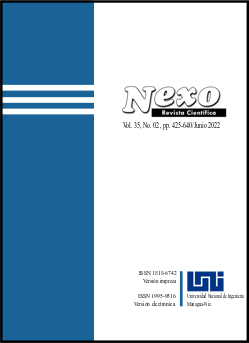Innovative solution using ion-electronic technology to purify the air from pathogenic microflora and create comfortable living conditions for humans
DOI:
https://doi.org/10.5377/nexo.v35i02.14635Keywords:
Volatile matter of woody plants, Fine dust, Methods of prevention of respiratory organs, Nanotechnology, InnovationsAbstract
According to the Federal State Statistics Service regarding respiratory diseases in Krasnoyarsk Krai, the increase in this indicator was 6% over the five years, and the increase in oncologic diseases was 4% over the same period. Polluted air is one of the leading causes of the increased incidence. The paper aims to find ways to clean indoor air using ion-electronic technology and bring the microclimate parameters to optimal values in cold and warm seasons. Experimental and theoretical studies substantiated the possibility of developing a device capable of creating and maintaining an air environment in closed premises, close in terms of indicators to the healthy air of ecologically clean regions. The device can have different performance and can be used in domestic, industrial, and public premises. Depending on the mode of operation and purpose, this device can be both stationary and mobile. Fine dust cannot be removed from the room even if the air exchange rate is increased by 200 and 400 times. It has been experimentally proven that ion-electronic technology and volatile matter of woody plants remove dust to achieve a clean room. This concept formed the basis for developing a device using nanotechnology combined with the volatile matter of woody plants. The dependences of the influence of artificial ionization of air and volatile matter of woody plants on reducing the amount of fine dust and pathogenic microflora are theoretically substantiated. The air purified in this way maintains immunity and reduces the incidence of respiratory diseases, which has been proven experimentally based on a prototype of the developed device.
Downloads
1369
Downloads
Published
How to Cite
Issue
Section
License
Copyright (c) 2022 Universidad Nacional de Ingeniería

This work is licensed under a Creative Commons Attribution 4.0 International License.
The authors who publish in Nexo Scientific Journal agree to the following terms:
- Authors retain the copyright and grant the journal the right of the first publication under the license Creative Commons Attribution License, which allows others to share the work with a recognition of the authorship of the work and the initial publication in Nexo Scientific Journal.
- Authors may separately establish additional agreements for the non-exclusive distribution of the version of the work published in the journal (for example, in an institutional repository or a book), with the recognition of the initial publication in Nexo Scientific Journal.
- Authors are allowed and encouraged to disseminate their works electronically (for example, in institutional repositories or in their own website) before and during the submission process, as it can lead to productive exchanges, as well as earlier and greater citation of published works.










